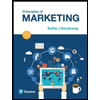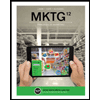MKTG 344 Mid-Term Study Guide
.docx
keyboard_arrow_up
School
Prairie State College *
*We aren’t endorsed by this school
Course
201
Subject
Marketing
Date
Apr 3, 2024
Type
docx
Pages
2
Uploaded by jamyl1999
Marketing 344 Mid-Term Preparation: Key Terms to Know & Apply
Chapter 1
Define strategic planning and its function (pg. 15-16)
How has the increased availability of information affected power in the supply chain? (pg. 3)
What happens in mature markets to competition and perceived differentiation? Define commoditization (pg. 2)
What is media fragmentation? What advantages and disadvantages has it provided advertisers? (pg. 4)
Define “product” and its scope in today’s marketplace (pgs. 10-11)
Define Product Positioning & Branding (pg. 19)
Understand the evolution of Marketing from planning the Marketing mix to value creation for customers (pg. 7-8)
Chapter 2 & 3
What is a mission statement? How does it differ from a vision statement and why is it important to marketing strategy? (pgs. 30-34)
How has the marketing concept evolved in the twenty-first century? (pg. 46-47)
What is the Purchase Funnel and why is it important for Marketers to understand and apply? (Purchase Funnel worksheet)
Sarbanes-Oxley Act of 2002
What are the major trends in U.S. sociocultural environment (pg. 77)
Chapter 5
Data mining process and insight (pg. 120)
Define the Consumer buying process (Exhibit 5.1) pg. 122
What is Market segmentation and why do Marketers use it? (pgs. 133-138)
How are segments analyzed for possible selection as target market(s)? What is lifetime value of a customer (LTV)? (Refer to Segmentation worksheet)
Identify the different data types used in segmentation- Demographic (age, income, etc.), Behavior (purchase, usage), Psychographic (needs, preferences, lifestyle, attitudes) pgs. 139-144. Behavioral segmentation is usually most predictive.
Population diversity growth Define Mass Marketing, Differentiated Marketing and Niche marketing; identify benefits and challenges (pg. 134-136)
Define and apply mass-customization Lecture & PP on segmentation (week 3 folder)
Chapter 4
SWOT Matrix process, goals and applications (Exhibit 4.5) Pg. 96-98
Define core competency and understand how it can translate to competitive advantage (Exhibit 4.8) pg. 106-107
Apply the SWOT matrix (pgs. 99-100)
What are the various types of differentiation and why are they important?
Chapter 7
Identify the reasons retailers focus on private label brands? Which is most important to retailers? Pgs. 208 (Exhibit 7.3)
Identify the main benefits of brand equity. What is brand value? (pgs. 209-210).
How are perceptual maps used for identifying positioning issues and opportunities? (pgs. 214)
Define the stages of the product life cycle and the appropriate strategic considerations in each. Which stage holds the greatest opportunity for growth and profitability? Exhibit 7.8
what are appropriate strategy options in each phase? Exhibit 7.9 (pgs. 218-219). Define co-branding and licensing. (pg. 209). Clarify Differentiation vs. Positioning (pg. 213-214).
When should a brand reposition (rebrand)? What are the benefits? Nintendo pgs. 225-226
What is increase “share-of-customer”? How is it employed in the marketplace? Pg. 223
Your preview ends here
Eager to read complete document? Join bartleby learn and gain access to the full version
- Access to all documents
- Unlimited textbook solutions
- 24/7 expert homework help
Related Questions
B. Consumer Markets & Consumer Buyer Behavior
Marketing by the Numbers Evaluating Alternatives
One way consumers can evaluate alternatives is to identify important attributes and assess
how purchase alternatives perform on those attributes. Consider the purchase of an
automobile. Each attribute, such as gas mileage, is given a weight to reflect its level of
importance to that consumer. Then the consumer evaluates each alternative on each
attribute. For example, in the table, gas mileage (weighted at 0.5) is the most important
attribute for this consumer. The consumer believes that Brand C performs best on gas mileage,
rating it 7 (higher ratings indicate higher performance). Brand B is perceived as performing
the worst on this attribute (rating of 3). Styling and price are the consumer's next most
important attributes. Warrant is least important. A score can be calculated for each brand by
multiplying the importance weight for each attribute by the brand's score on that attribute.…
arrow_forward
Analyse the advertising and
communication
that the company uses to
communicate with the consumers of your
chosen breakfast cereal
2.1 Choose any product advert or
communication and evaluate the
consumption-specific bases
of segmentation that was applied.
2.2 Find adverts with examples of how the
company is aiming to provide customer
value, ensure customer satisfaction, build
customer trust, and secure customer
retention
2.3 Do you think that the company has
managed to get a competitive advantage
in marketing
this product? Motivate your answer.
arrow_forward
Please explain the different marketing management orientations in one paragraph.
arrow_forward
When BCG revised its advice about how to use its matrix, it determined that market share was less important in driving a firm’s profitability. It included new drivers of performance. What is one of these new drivers?
arrow_forward
1. Consider yourself a Marketing Manager. Explain how you would develop an effectivemarketing strategy for a Credit Card product using video streaming as a promotionalchannel.2. Discuss the merits and benefits of sales promotion in the context of marketing. Provideexamples to illustrate your points.3. Describe the marketing mix decisions (product, distribution, promotional, pricing) thatmarketers face. Choose a real-world product or service and apply the marketing mixdecisions to it, explaining your choices.
arrow_forward
Marketing concepts and marketing managers
article to support each of the
marketing concept:
1Product profitablility models
2Strategies to engage shareholders in new product
development
3Evaluate marketing mix alternatives
4Internal/External risks associated wiht new product
development
Provide a brief explanation of why each article was chosen
and what specific advice it offers to the Marketing Managers Can you do this
separately for each article as well as provide the full reference for the
article thanks
arrow_forward
1. Explain the concept of Guerilla Marketing. Give example.
arrow_forward
Explain what is product placement?2. You are to cite two (2) examples of recent product placements that you have seen on your local television, cableor at the cinema (do not cite examples from the textbook or copy those sourced from the internet).3. Identify and explain two (2) consumer behavior theories that can be applied to explain the use of productplacement by marketers.4. Discuss four (4) argument for marketers’ use of product placement and four (4) argument against marketers’ useof product placement. Your argument should address both practical issues (product sales) and ethical issuessurrounding the use of product placement.
arrow_forward
1. You are employed as a Marketing Coordinator at a company that manufactures
motorboats. Compare how the products it offers, prices it charges, distribution strategy it
pursues and promotional campaigns ituses differif it chooses THREE (3) undifferentiated
and TWO (2) differentiated market targeting (coverage) strategy
arrow_forward
No. 3: Many cosmetics company advertise their products with glamorous models as agents. The implicit message is to create an association between their products and beauty in minds of consumers and projecting beautiful models as more successful. This trend has put many psychologically weak people under stress.
Do you think it is ethical to portray beauty as the only outcome of cosmetic products?
What reasons other than glamor can be used in advertisements for attracting people for buying and using cosmetics?
arrow_forward
describe the marketing mix (7Ps) in relation to business opportunity vis-a-vis:
a. product
b. place
c. price
d. promotion
e. people
f. packaging
g. positioning
arrow_forward
answer number 3 only
arrow_forward
Marketing plan section
(15)
arrow_forward
What role should a sales force play in the ma.li:etjng communicationsplan? How should direct marketing be used?
arrow_forward
1. What are the importance of having Customer Relationship Management in a company? State at least three advantages of having CRM in the company
2. Give one company that represents Color Marketing and know the reason why they use that color.
arrow_forward
Put this in other words. Analyze and elaborate this one.
In an era where customers wield the power to procure what they desire, when and where they wish, predictive analytics assumes paramount significance in the realm of marketing. By generating insightful models, predictive analytics empowers marketers to fashion campaigns of unprecedented precision and effectiveness. The canvas of predictive marketing analytics is a vast one, spanning data-driven customer segmentation, novel customer acquisition strategies, lead scoring, personalized content and ad recommendations, and hyper-personalized interactions. Marketers adroitly harness customer data to deliver tailored promotions, advertisement campaigns, and product suggestions at precisely opportune moments, thereby amplifying customer satisfaction and fostering enduring loyalty.
arrow_forward
Which platform did Mr. Ray’s marketing team advise him to use for the launch of a new product?
Mr. Ray is looking for a platform to launch his product. His marketing team advises him to launch the product via newspaperssocial mediabillboardsas it is free advertising and improvesproduct qualityconsumer welfarebrand recognition.
arrow_forward
1. A company that sells products to be used primarily by the general public is known as a?
2. According to the chapter readings on differentiated marketing (Module 3), the McDonald's: Segmentation, Targeting, and Positioning video clip shown in depicts differentiated marketing. True or False?
3. When defining the concept of marketing, the following four activities must be included: True or false
arrow_forward
20.- What is market segmentation and why is it important?
arrow_forward
discuss...what is the purpose of promotion and how do marketers use it to increase the chance a consumer will buy their product or service?
arrow_forward
In order for an organization to produce a successful marketing plan, there are many elements to consider. Describe what it means by "advertising clutter" and how marketers can avoid content clutter.
arrow_forward
Discussion - Ethics in Healthcare Marketing
Few aspects of marketing were of greater concern to health care professionals than the onset of advertising. Because of the sensitive nature of healthcare and the often precarious position of the health care buyer, there is heightened sensitivity to the use of this tool. This concern is often positioned around the ethics of marketing. Please conduct scholarly research on one recent topic (within the last 5-10 years) related to ethics in healthcare marketing and discuss your findings. What does the Code of EthicsLinks to an external site. from the Society of Healthcare Strategy and Market Development, American Hospital Association, and/or the American College for Healthcare Executives have to say about the issue you located? Responses should be supported by research from scholarly peer-reviewed resources.
arrow_forward
Marketing Questions
1. The task of designing, collecting, analyzing and reporting, known as ________ is intended to define marketing problems or opportunities.
2. The buyer’s willingness and ability to buy along, buyer’s consideration to alternative brands, and their income are determinants of _______.
3. A _____ is designed to avoid direct competition of larger companies pursuing the bigger segments.
4. A(n)_____________________ attempts to maintain a strong position in its core product-market(s) but also seeks to expand into new (often closely) related markets.
5. The analysis of how consumer perceive one’s brand in comparison to the competition is known as ______.
6. Companies that establish formal policies and guidelines to ensure that the messages communicated to the customer reflect their unique values and competencies are creating a ____________________________.
7. The rate at which an innovative new product category passes through the _________________________ is…
arrow_forward
2. Marketing has often been defined in terms of satisfying customers' needs and wants. Critics, however, maintain that marketing goes beyond that and creates needs and wants that did not exist before. They feel marketers encourage consumers to spend more money than they should on goods and services they do not really need.
Take a position: Marketing shapes consumer needs and wants versus marketing merely reflects the needs and wants of customers.
arrow_forward
SEE MORE QUESTIONS
Recommended textbooks for you

Principles Of Marketing
Marketing
ISBN:9780134492513
Author:Kotler, Philip, Armstrong, Gary (gary M.)
Publisher:Pearson Higher Education,

Marketing
Marketing
ISBN:9781259924040
Author:Roger A. Kerin, Steven W. Hartley
Publisher:McGraw-Hill Education

Foundations of Business (MindTap Course List)
Marketing
ISBN:9781337386920
Author:William M. Pride, Robert J. Hughes, Jack R. Kapoor
Publisher:Cengage Learning

Marketing: An Introduction (13th Edition)
Marketing
ISBN:9780134149530
Author:Gary Armstrong, Philip Kotler
Publisher:PEARSON


Contemporary Marketing
Marketing
ISBN:9780357033777
Author:Louis E. Boone, David L. Kurtz
Publisher:Cengage Learning
Related Questions
- B. Consumer Markets & Consumer Buyer Behavior Marketing by the Numbers Evaluating Alternatives One way consumers can evaluate alternatives is to identify important attributes and assess how purchase alternatives perform on those attributes. Consider the purchase of an automobile. Each attribute, such as gas mileage, is given a weight to reflect its level of importance to that consumer. Then the consumer evaluates each alternative on each attribute. For example, in the table, gas mileage (weighted at 0.5) is the most important attribute for this consumer. The consumer believes that Brand C performs best on gas mileage, rating it 7 (higher ratings indicate higher performance). Brand B is perceived as performing the worst on this attribute (rating of 3). Styling and price are the consumer's next most important attributes. Warrant is least important. A score can be calculated for each brand by multiplying the importance weight for each attribute by the brand's score on that attribute.…arrow_forwardAnalyse the advertising and communication that the company uses to communicate with the consumers of your chosen breakfast cereal 2.1 Choose any product advert or communication and evaluate the consumption-specific bases of segmentation that was applied. 2.2 Find adverts with examples of how the company is aiming to provide customer value, ensure customer satisfaction, build customer trust, and secure customer retention 2.3 Do you think that the company has managed to get a competitive advantage in marketing this product? Motivate your answer.arrow_forwardPlease explain the different marketing management orientations in one paragraph.arrow_forward
- When BCG revised its advice about how to use its matrix, it determined that market share was less important in driving a firm’s profitability. It included new drivers of performance. What is one of these new drivers?arrow_forward1. Consider yourself a Marketing Manager. Explain how you would develop an effectivemarketing strategy for a Credit Card product using video streaming as a promotionalchannel.2. Discuss the merits and benefits of sales promotion in the context of marketing. Provideexamples to illustrate your points.3. Describe the marketing mix decisions (product, distribution, promotional, pricing) thatmarketers face. Choose a real-world product or service and apply the marketing mixdecisions to it, explaining your choices.arrow_forwardMarketing concepts and marketing managers article to support each of the marketing concept: 1Product profitablility models 2Strategies to engage shareholders in new product development 3Evaluate marketing mix alternatives 4Internal/External risks associated wiht new product development Provide a brief explanation of why each article was chosen and what specific advice it offers to the Marketing Managers Can you do this separately for each article as well as provide the full reference for the article thanksarrow_forward
- 1. Explain the concept of Guerilla Marketing. Give example.arrow_forwardExplain what is product placement?2. You are to cite two (2) examples of recent product placements that you have seen on your local television, cableor at the cinema (do not cite examples from the textbook or copy those sourced from the internet).3. Identify and explain two (2) consumer behavior theories that can be applied to explain the use of productplacement by marketers.4. Discuss four (4) argument for marketers’ use of product placement and four (4) argument against marketers’ useof product placement. Your argument should address both practical issues (product sales) and ethical issuessurrounding the use of product placement.arrow_forward1. You are employed as a Marketing Coordinator at a company that manufactures motorboats. Compare how the products it offers, prices it charges, distribution strategy it pursues and promotional campaigns ituses differif it chooses THREE (3) undifferentiated and TWO (2) differentiated market targeting (coverage) strategyarrow_forward
- No. 3: Many cosmetics company advertise their products with glamorous models as agents. The implicit message is to create an association between their products and beauty in minds of consumers and projecting beautiful models as more successful. This trend has put many psychologically weak people under stress. Do you think it is ethical to portray beauty as the only outcome of cosmetic products? What reasons other than glamor can be used in advertisements for attracting people for buying and using cosmetics?arrow_forwarddescribe the marketing mix (7Ps) in relation to business opportunity vis-a-vis: a. product b. place c. price d. promotion e. people f. packaging g. positioningarrow_forwardanswer number 3 onlyarrow_forward
arrow_back_ios
SEE MORE QUESTIONS
arrow_forward_ios
Recommended textbooks for you
 Principles Of MarketingMarketingISBN:9780134492513Author:Kotler, Philip, Armstrong, Gary (gary M.)Publisher:Pearson Higher Education,
Principles Of MarketingMarketingISBN:9780134492513Author:Kotler, Philip, Armstrong, Gary (gary M.)Publisher:Pearson Higher Education, MarketingMarketingISBN:9781259924040Author:Roger A. Kerin, Steven W. HartleyPublisher:McGraw-Hill Education
MarketingMarketingISBN:9781259924040Author:Roger A. Kerin, Steven W. HartleyPublisher:McGraw-Hill Education Foundations of Business (MindTap Course List)MarketingISBN:9781337386920Author:William M. Pride, Robert J. Hughes, Jack R. KapoorPublisher:Cengage Learning
Foundations of Business (MindTap Course List)MarketingISBN:9781337386920Author:William M. Pride, Robert J. Hughes, Jack R. KapoorPublisher:Cengage Learning Marketing: An Introduction (13th Edition)MarketingISBN:9780134149530Author:Gary Armstrong, Philip KotlerPublisher:PEARSON
Marketing: An Introduction (13th Edition)MarketingISBN:9780134149530Author:Gary Armstrong, Philip KotlerPublisher:PEARSON
 Contemporary MarketingMarketingISBN:9780357033777Author:Louis E. Boone, David L. KurtzPublisher:Cengage Learning
Contemporary MarketingMarketingISBN:9780357033777Author:Louis E. Boone, David L. KurtzPublisher:Cengage Learning

Principles Of Marketing
Marketing
ISBN:9780134492513
Author:Kotler, Philip, Armstrong, Gary (gary M.)
Publisher:Pearson Higher Education,

Marketing
Marketing
ISBN:9781259924040
Author:Roger A. Kerin, Steven W. Hartley
Publisher:McGraw-Hill Education

Foundations of Business (MindTap Course List)
Marketing
ISBN:9781337386920
Author:William M. Pride, Robert J. Hughes, Jack R. Kapoor
Publisher:Cengage Learning

Marketing: An Introduction (13th Edition)
Marketing
ISBN:9780134149530
Author:Gary Armstrong, Philip Kotler
Publisher:PEARSON


Contemporary Marketing
Marketing
ISBN:9780357033777
Author:Louis E. Boone, David L. Kurtz
Publisher:Cengage Learning